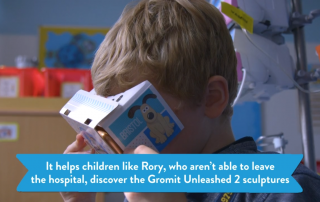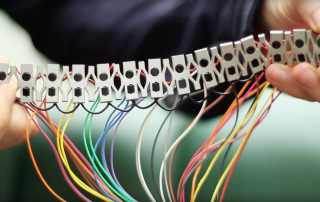Gromit VR Experience
The BIG Lab’s Gareth Barnaby has helped develop a Virtual Wallace and Gromit experience for children at the Bristol Children’s Hospital! This summer, thousands of people enjoyed the Grand Appeal’s Gromit Unleashed 2 trail, which saw 67 sculptures of Aardman characters Wallace, Gromit and Feathers McGraw enlivening the streets, buildings and parks of Bristol. Gareth worked with Wallace & Gromit’s Grand Appeal and local games company Large Visible Machine to put together ‘Gromit Unleashed 2 VR Experience’ a virtual Gromit-trail experience which allowed patients at Bristol Children’s Hospital to experience the sculpture trail without leaving the hospital. Cracking! Read more
Eight papers accepted at CHI 2018
Our latest work will be presented at CHI next week. We have eight papers accepted including two honorables mentions.
Isabel Qamar, Rainer Groh, David Holman and Anne Roudaut.
HCI meets Material Science: A Literature Review of Morphing Materials for the Design of Shape-Changing Interfaces. In the proceeding of the Conference on Human Factors in Computing Systems. 2018. ACM. Honorable mention.
Hyunyoung Kim, Celine Coutrix, Anne Roudaut. Morphees+: Refining the Shape Resolution Taxonomy Through Everyday Reconfigurable Objects. In the proceeding of the Conference on Human Factors in Computing Systems. 2018. ACM. Honorable mention.
Jason Alexander, Anne Roudaut, Jürgen Steimle, Kasper Hornbæk, Miguel Bruns Alonso, Sean Follmer, Timothy Merritt. Grand Challenges in Shape-Changing Interface Research. In the proceeding of the Conference on Human Factors in Computing Systems. 2018. ACM.
Hyunyoung Kim, Celine Coutrix, Anne Roudaut. KnobSlider: Bottom-Up Design of a Shape-Changing UI for Parameters Control. In the proceeding of the Conference on Human Factors in Computing Systems. 2018. ACM.
Rachel Eardley, Anne Roudaut, Steve Gill, Stephen J Thompson. Investigating How Smartphone Movement is Affected by Body Posture. In the proceeding of the Conference on Human Factors in Computing Systems. 2018. ACM.
Oussama Metatla, Clare Cullen. “Bursting the Assistance Bubble”: Designing Inclusive Technology with Children with Mixed Visual Abilities. In the proceeding of the Conference on Human Factors in Computing Systems. 2018. ACM.
Oussama Metatla, NIck Bryan-Kinns, Tony Stockman. “I Hear You”: Understanding Awareness Information Exchange in an Audio-only Workspace. In the proceeding of the Conference on Human Factors in Computing Systems. 2018. ACM.
Amid Ayobi, Tobias Sonne, Paul Marshall, Anna L Cox. Flexible and Mindful Self-Tracking: Design Implications from Paper Bullet Journals for Personal Informatics. In the proceeding of the Conference on Human Factors in Computing Systems. 2018. ACM.
SensIR presented at UIST 2017
Jess McIntosh, a PhD student in our group, recently went to UIST 2017 in Quebec city to present his work on in-air hand gesture detection using infrared sensors.
You can watch Jess’ talk here:
8 Summer Interns conducting Research within BIG
This summer, 8 Interns are conducting research in the BIG and uNDT lab:
Abanoub Ghobrial -> Acoustic Tractor Beams with Metasurfaces
Anne-Claire Bourland -> EMG detection of mumbled and suvocalized words
Peter Gorman -> Beamformer Parametric Speaker
Patricia Deud -> Analysis of grasp gestures
Ravi Singh -> 3D printing with Ultrasound and DLP projectors
Tom Corkett -> Arrays of microphones for interactive sound location and focused listening.
Luke Cox -> 3D Finite Differences Time Domain simulations of wave propagation on metamaterials
Rhys Hodson -> Acoustic Abduction Rays
In the picture (from left to right): top) Abanoub Ghobrial, Peter Gorman, Anne-Claire Bourland, Tom Corkett; bottom) Asier Marzo and Jess McIntosh.
10 papers and 8 late breaking work accepted to CHI 2016
Bristol Interaction Group will present 10 papers and 8 late breaking work at ACM CHI 2016.
The following are our 10 papers and notes
Investigating Text Legibility on Non-Rectangular Displays
![]() Understanding and Mitigating the Effects of Device and Cloud Service Design Decisions on the Environmental Footprint of Digital Infrastructure
Understanding and Mitigating the Effects of Device and Cloud Service Design Decisions on the Environmental Footprint of Digital Infrastructure
Tap the ShapeTones: Exploring the effects of crossmodal congruence in an audio-visual interface
EMPress: Practical Hand Gesture Classification with Wrist-Mounted EMG and Pressure Sensing
Office Social: Presentation Interactivity for Nearby Devices
GauntLev: A Wearable to Manipulate Free-floating Objects
Shared Language and the Design of Home Healthcare Technology
PathSync: Multi-User Gestural Interaction with Touchless Rhythmic Path Mimicry
PowerShake: Power Transfer Interactions for Mobile Devices The
Tyranny of the Everyday in Mobile Video Messaging
Running out of smartphone battery could be a thing of the past, thanks to power sharing between devices.
We are pleased to announce The Economist has published an article on a paper by BIG researchers Paul Worgan, Jarrod Knibbe, Diego Martinez Plasencia and Mike Fraser.
The paper presents a power sharing concept called PowerShake. PowerShake enables users to share power across their multiple mobile devices, such as smartphones, tablets and smartwatches, using inductive power transfer. Today we are beginning to carry multiple mobile devices, though the energy is used at different rates across each of the devices, meaning one device could have near full battery and another almost no battery. PowerShake allows users to transfer energy, for example, from their tablet to their phone to support an important phone call. PowerShake also allows users to share or trade power with others, including friends, family and colleagues, on-the-go and all without charging cables.
Watch the PowerShake video for more information.








